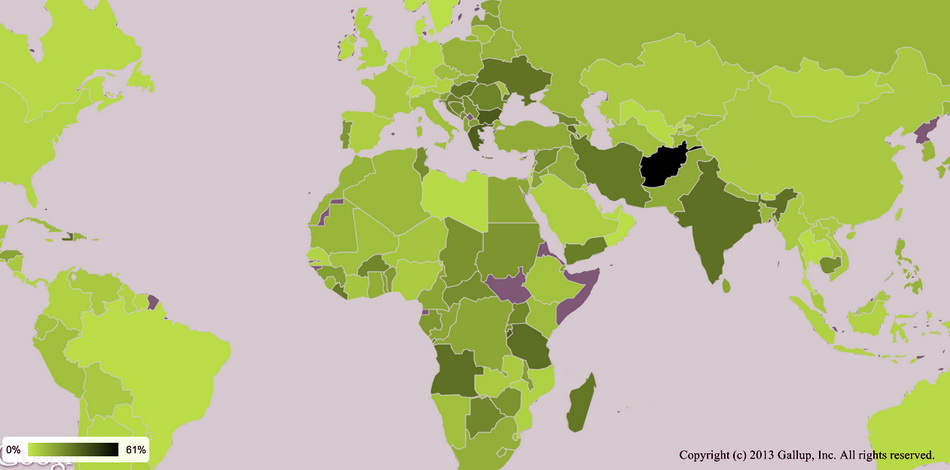The Gallup World Poll reveals the worst pockets of global suffering. On the map above, the darker the nation’s color, the worse the suffering, and the countries in faint color had the least suffering. The map highlights that the most extreme suffering on the globe in 2018 occurred in three geographic regions: Africa, the Middle East, and Southeastern Europe. In this report suffering was presumed if a person said their life was close to “the worse possible life.” It was presumed if a person agreed that they had suffered “pain a lot of the day yesterday.”
The countries with the greatest amount of suffering in 2018 were Chad, South Sudan, Burundi, Yemen, Afghanistan, Iraq, and Haiti. You may notice that most of these countries have had a great deal of violent conflict in recent years.
Gallup’s annual world poll in 2018 reported that Chad had the most “pain-stricken and sad people in the world.” Two-thirds of them when surveyed said that they had experienced physical pain during most of the previous day. And over half said they had felt sad through much of yesterday. In recent years Chadians have suffered frequent killings by Boko Haram as well as other regional fighting groups. Chad is one of five African nations in the Sahel region that have suffered from frequent attacks by militant Islamic groups. Chad, a nation of 13 million, has a reputation as one of the poorest and most corrupt countries in the world.
For several years, Iraq has remained on Gallup’s list of top five countries with the “Highest Negative Experiences,” according to the Gallup Global Emotions annual reports. Not only did Iraq have a lot of people feeling stressed and angry but nearly half reported feeling worried and sad. In the past two years Iraq has experienced repeated bombings, protests and other chaos producing events. The Iraqi Insurgency continues with mostly Sunni rebel groups fighting the Shia-led Government. Many in Iraq suffer from unemployment, poverty and poor access to health services. Iraq as well as Chad have huge refugee populations.
Suffering and social wellbeing vary from day to day and year to year. As suffering results from societal challenges like poverty, violence, and intolerance, we can expect suffering to be increasing across years in some countries but decreasing in other nations. Neither suffering nor other major indicators of the quality of life in societies remain stagnate, although in most affluent countries the level of subjective suffering and related aspects of the quality of life tend to remain fairly constant. Extreme suffering will predominate in countries ravaged by civil war and those with a large number of its citizens trapped in impoverished living conditions.
Gallup World Poll Data. The charts above capture findings from 1,250,000 interviews in 150 countries representing 98% of the world population across the past eight years. In each year and each country a minimum of 1,000 randomly selected adults are interviewed for the Gallup World Poll. Interviews are conducted in respondent’s native language in person or by phone. For this article, the data were retrieved through the Gallup Analytics portal. More details can be obtained from the Poll’s Methodology Report.
Gallup’s “Suffering Index” is based upon a series of questions that measure respondents’ perceptions of where they stand, now and in the future. Individuals who rate their current lives as an average of “4” or lower are defined as ‘suffering.’ All other individuals are considered ‘not suffering.’ Their objective with this index is to identify persons with such extreme dissatisfaction with their lives that they, in fact, are suffering.


Comments 4
Tanna Gartside — January 26, 2020
Do you have something more up to date? this looks like figures for 2013??
I am involved with a church prayer group and we want to pray for countries where there is a tremendous amount of suffering for that reason, I wanted up to date information. Thank you for what you have given me here.
Kirdan — December 15, 2020
The map is for 2013, when the text is about 2018.